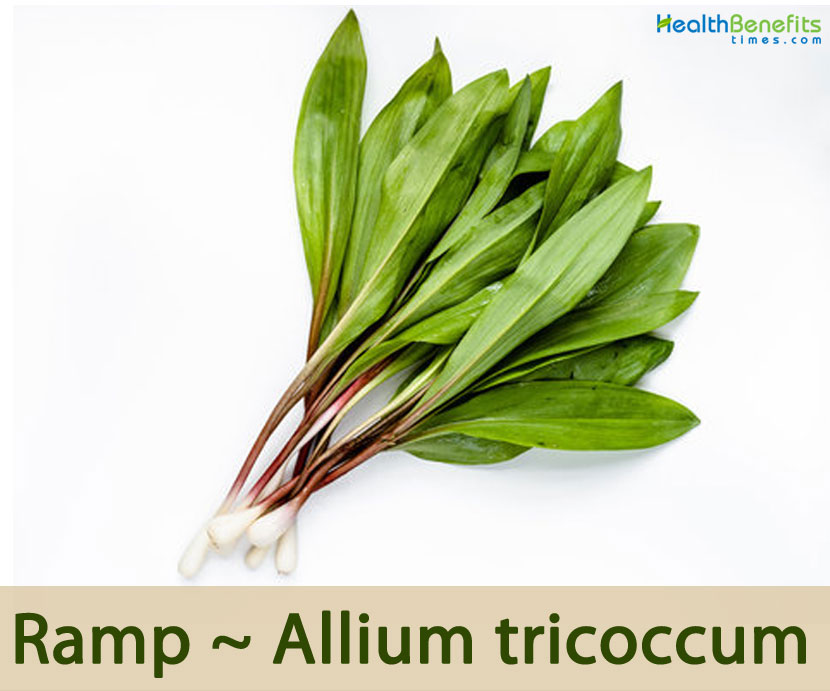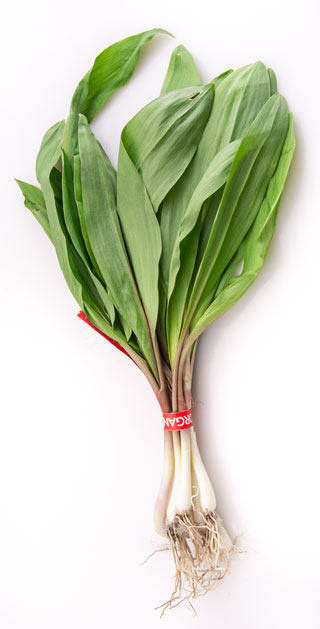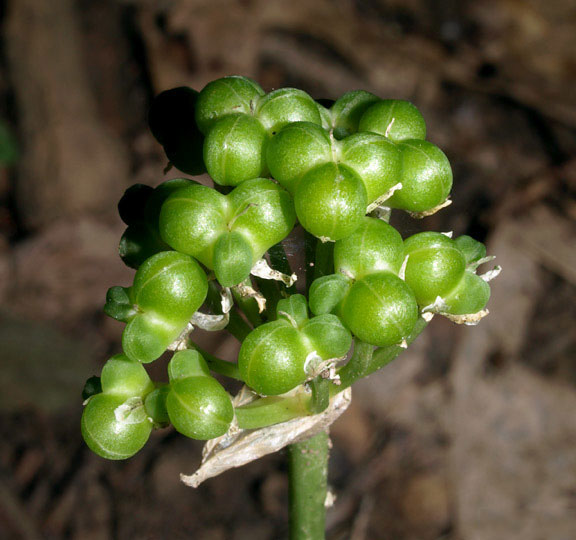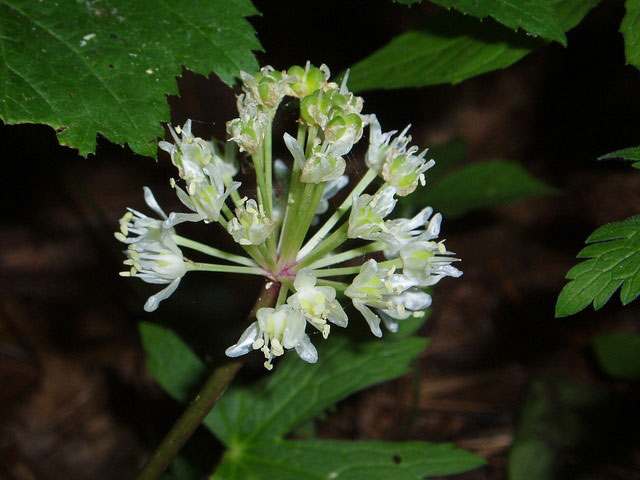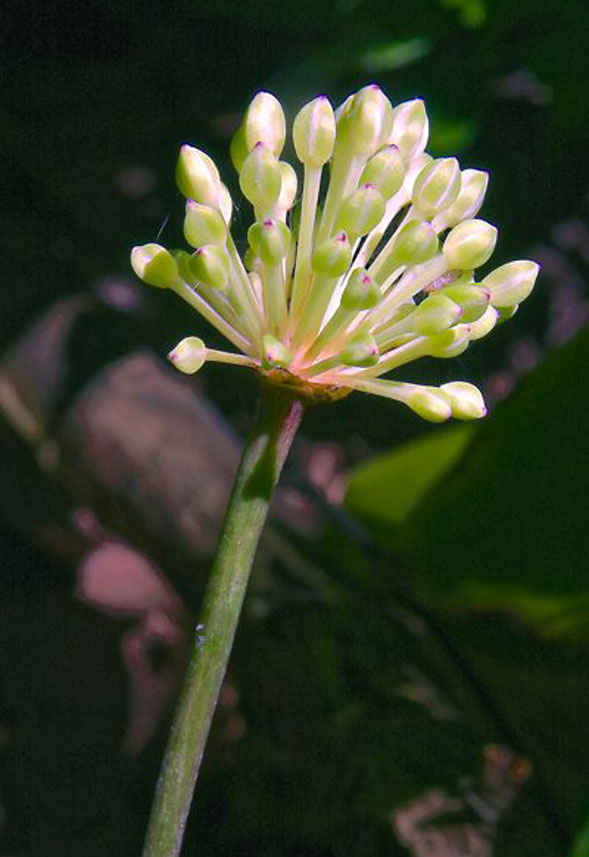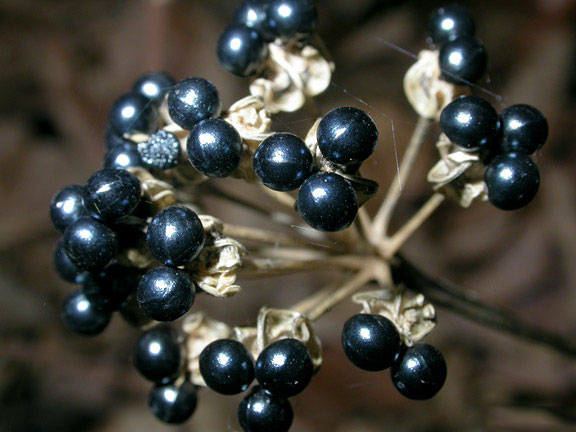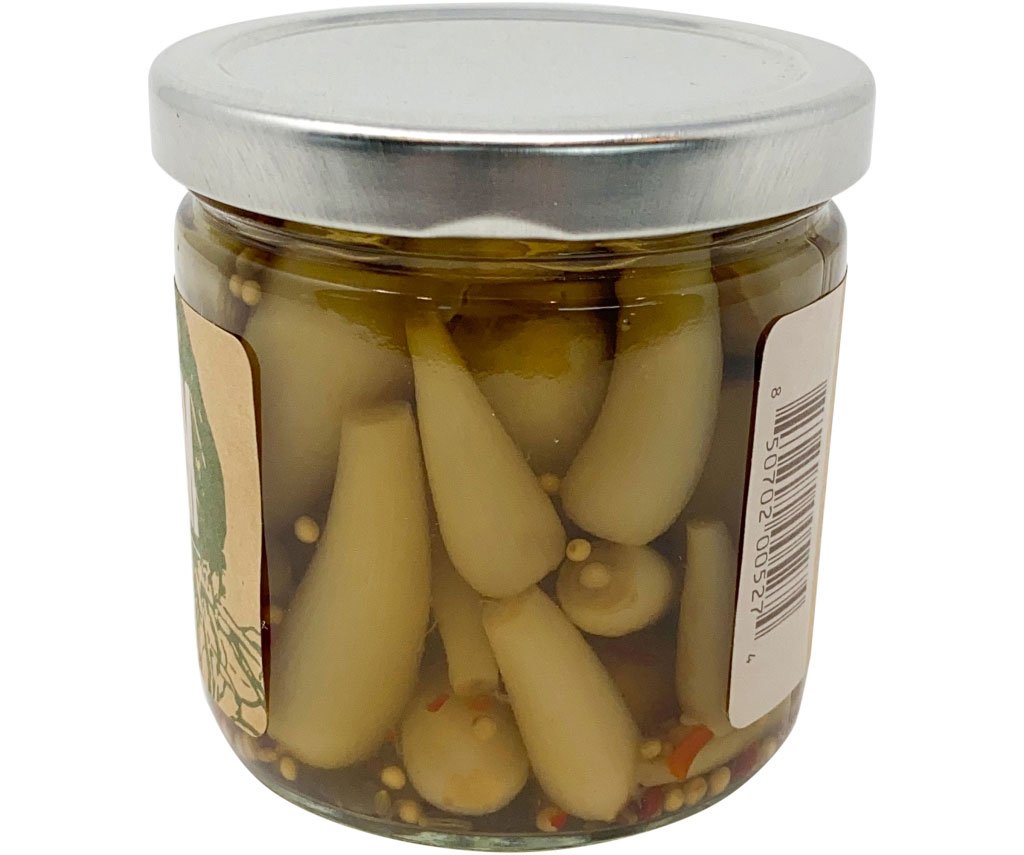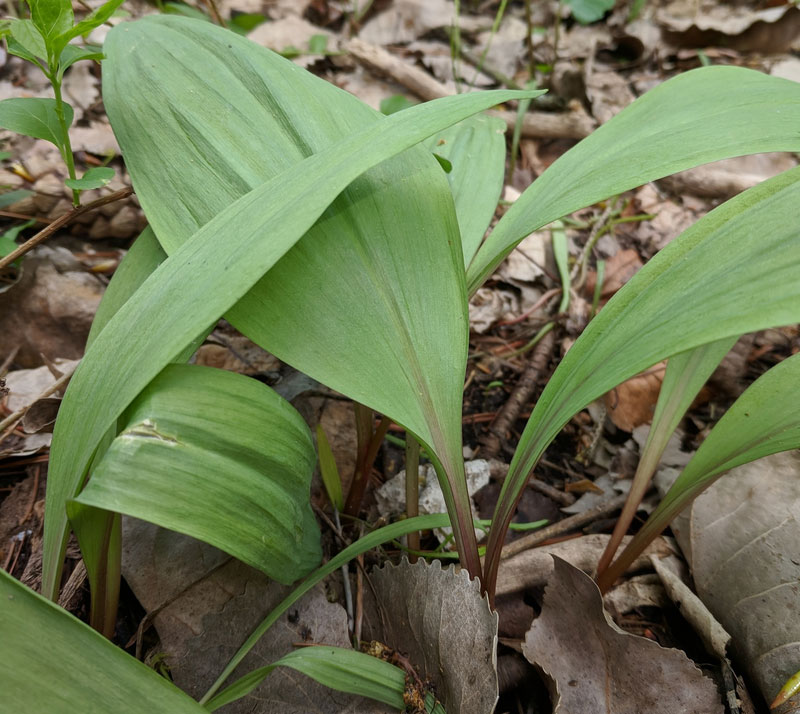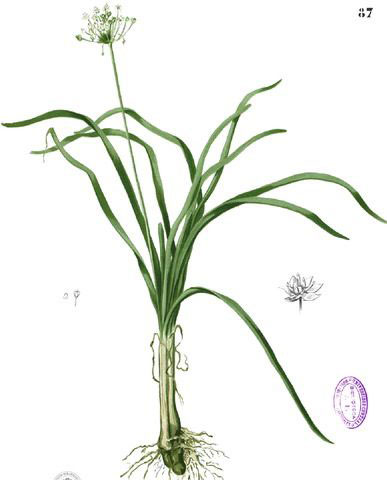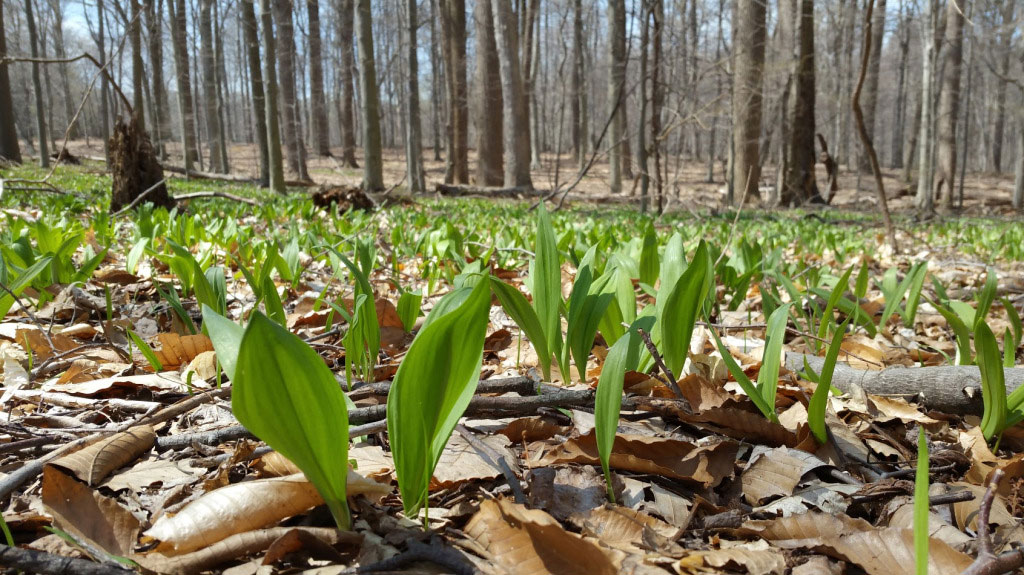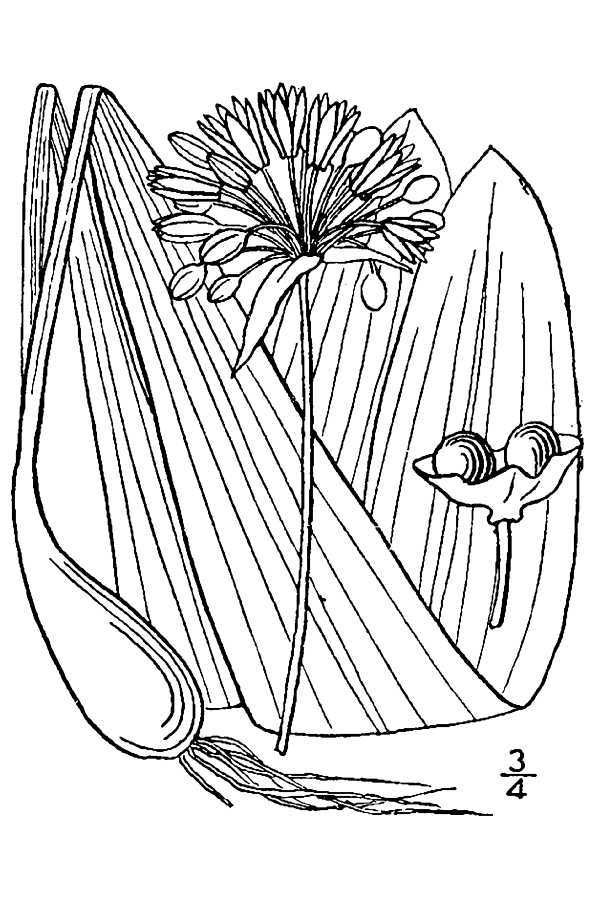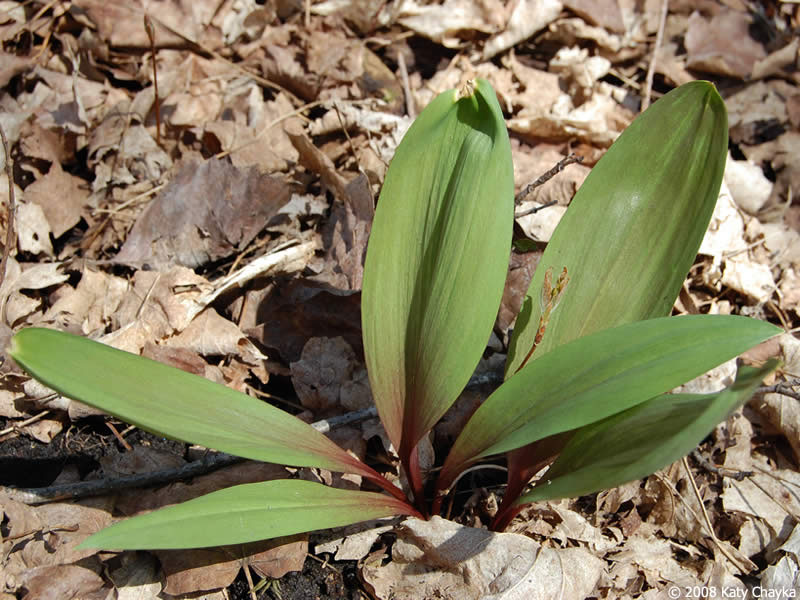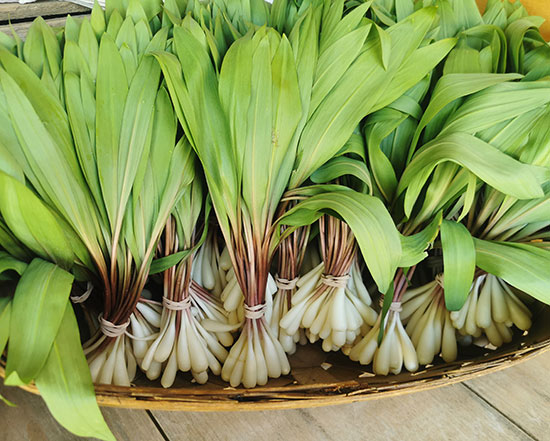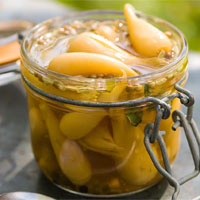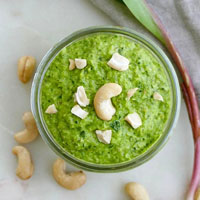There are two varieties of ramps, A. tricoccum var. tricoccum and A. tricoccum var. burdickii. The triccocum variety is dominant in the southern Appalachian Mountains and has a purple stem and larger leaves than the burdickii variety with up to 50 flowers in a cluster. The burdickii variety is more common in the northern mountains and has narrower leaves, green at the base and is shorter stalked, with 20 or fewer flowers per cluster. The specific epithet tricoccum refers to the possession of three seeds.
Ramp Facts
| Ramp Quick Facts | |
|---|---|
| Name: | Ramp |
| Scientific Name: | Allium tricoccum |
| Origin | North America, particularly in eastern Canada and the northern and southeastern United States |
| Colors | Green when young turning to black when mature |
| Shapes | Three-celled seed capsule. |
| Taste | Delicious, sweet and pungent taste |
| Health benefits | Heart Health, Treat and Prevent Cancer, prevent high blood pressure and stroke, High in antioxidants, |
| Name | Ramp |
|---|---|
| Scientific Name | Allium tricoccum |
| Native | North America, and grow wild particularly in eastern Canada and the northern and southeastern United States, especially in the New England states such as Massachusetts, Maine, Connecticut, Rhode Island, Vermont, and New Hampshire |
| Common Names | Wild Leek, Wood Leek, ramp, ramps, ramson, wood leek, wild garlic, Spring Onion |
| Name in Other Languages | Afrikaans: Oprit Albanian: Luftoj Amharic: Mewet’ach’a (መወጣጫ) Arabic: Almunhadir (المنحدر) Armenian: Korzum (կորզում) Azerbaijani: ərşə qalxmaq Basque: Arrapala Belarusian: Pakhil (пахіл) Bengali: Ḍākāti (ডাকাতি) Bosnian: Rampa Bulgarian: Rampa (рампа) Catalan: Rampa Cebuano: Rampa Chichewa: Limbikitsa Chinese: Xiántī (舷梯) Corsican: Rampa Croatian: Rampa Czech: Rampa Danish: Rampe Dutch: Oprit English: Ramp, Small white leek, Wild leek, Wood leek, Small wild leek Esperanto: Ramplo Estonian: Kaldtee Filipino: Rampa Finnish: Ramppi French: Rampe, Ail des bois, Ail sauvage, Ail trilobé Frisian: Oprit Galician: Rampa Georgian: Ramp German: Rampe Greek: Anavathmída (αναβαθμίδα) Gujarati: Rēmpa (રેમ્પ) Haitian Creole: Ranp Hausa: Gangara Hawaiian: Ramp Hebrew: רמפה Hindi: Badhaana (बढ़ाना) Hmong: Kev nce mus saum kev loj Hungarian: Rámpa Icelandic: Rampur Igbo: Ramp Indonesian: Lereng Irish: Rampa Italian: Rampa Japanese: Ranpu (ランプ) Javanese: Dalan Kannada: Lḷijāru (ಇಳಿಜಾರು) Kazakh: Qulama (құлама) Khmer: Bangkeun (បង្កើន) Kinyarwanda: Ramp Korean: Bitalgil (비탈길) Kurdish (Kurmanji): Kendal Kyrgyz: Pandws (пандус) Lao: Thang lad (ທາງລາດ) Latin: Circumdederunt munitionibus Latvian: Slīpums Lithuanian: Rampa Luxembourgish: Ramp Macedonian: Rampata (рампата) Malagasy: Fiakarana Malay: Tanjakan Malayalam: Rāmpil (റാംപിൽ) Maltese: Rampa Maori: Rōnaki Marathi: Utaraṇḍa (उतरंड) Mongolian: Khürne (хүрнэ) Myanmar (Burmese): Sangya hkway lyahaaw (ဆငျခွေလြှော) Nepali: Raimp (रैंप) Norwegian: Rampe Odia: ରେମ୍ପ Pashto: ریمپ Persian: سطح شیب دار, پیازچه بهاری Polish: Rampa Portuguese: Rampa Punjabi: Raimpa (ਰੈਂਪ) Romanian: Rampă Russian: Skat (скат) Samoan: Auala Sindhi: لاھين Sinhala: Kalabalaya (කලබලය) Scots Gaelic: Rampa Sesotho: Ramp Serbian: Rampa (рампа) Shona: Ramp Slovak: Rampa Slovenian: Ploščadi Somali: Gabagabeyso Spanish: Rampa Sudanese: Tanjakan Swahili: Njia panda Swedish: Ramp Tajik: Carx (чарх) Tamil: Valimaiyākkum (வலிமையாக்கும்) Tatar: Pandws (пандус) Telugu: Rāmp (రాంప్) Thai: Thāng lād (ทางลาด) Turkish: Rampa Turkmen: Rampa Ukrainian: Skat (скат) Urdu: ریمپ Uyghur: Ramp Uzbek: Qiyalik Vietnamese: Giốc Welsh: Ramp Xhosa: Ithambeka Yiddish: rampe (ראַמפּע) Yoruba: Rampu Zulu: Ummango |
| Plant Growth Habit | Bulbous, perennial herbaceous monocot plant |
| Growing Climates | Rich woods and bottoms, slopes, stream sides, beech and maple woods, rich forested mountainsides, rich cove forests, northern hardwood forests and other mesic slopes, mesic deciduous woodlands and wooded bluffs |
| Plant Size | 20-30 cm |
| Leaf | Two or three basal leaves that emerge from an underground bulb in early spring, and they grow about 15 to 30 cm (6 to 12 inches) long, and 2 to 10 cm (1 to 4 inches) wide |
| Flowering season | Late June to July |
| Flower | Flower measures about ¼ inch across and it comprises six tepals whose color varies from white to translucent |
| Fruit Shape & Size | Three-celled seed capsule |
| Fruit Color | Green when young turning to black when mature |
| Seed | Solitary globoid seed |
| Propagation | By seed |
| Taste | Delicious, sweet and pungent taste |
| Plant Parts Used | Bulbs, leaves |
| Varieties |
|
| Health Benefits |
|
Plant Description
Allium tricoccum is a bulbous, perennial herbaceous monocot plant that normally grows about 20 – 30 cm long and a flowering scape 10 – 40 cm tall from an underground bulb. The plant is found growing in rich woods and bottoms, slopes, stream sides, beech and maple woods, rich forested mountainsides, rich cove forests, northern hardwood forests and other mesic slopes, mesic deciduous woodlands and wooded bluffs. The wild leek’s root system comprises an ovoid bulb having fibrous roots at the bottom. Often offsets develop and they produce clonal colonies of wild leek.
Leaves
Wild leeks have two or three basal leaves that emerge from an underground bulb in early spring, and they grow about 15 to 30 cm (6 to 12 inches) long, and 2 to 10 cm (1 to 4 inches) wide. The petioles of the plant are hairless, reddish and below they are covered in a basal sheath. They are lance-elliptic, narrowed at both ends with a long tapered base. Leaves have a smooth leathery texture with faint parallel veins, toothless, dark green often tinged red at the base with a reddish stalk. They are downy along the margins. The flowering stalk is smooth and green or reddish, and starts emerging as the leaves wither away for the season.
Flower
Flowers appear 4 to 6 weeks after leaves have emerged, usually after they have withered away for the season. A flowering stalk measure anything between ½ inch and 1½ inches in height and develops between early and mid-summer. The stalk is glabrous and terete and its color varies from red to light green. A papery sheath covers the base of the stalk. A solitary round umbel of flowers measuring 1 to 2 inches across develops at the apex of the stalk. On an average, each umbel comprises about 20 to 40 flowers. A couple of deciduous bracts also appear at the foot of the rounded umbel.
Each flower of the wild leek plant measures about ¼ inch across and it comprises six tepals whose color varies from white to translucent. Ovary is light green to pale yellow in color and six stamens grow from it. In addition to a solitary white style, the stamens have yellow anthers. Slender white to greenish white pedicel is found at the base of every flower. The plant is in bloom during summer and the flowering season lasts for around two weeks. Flowers as well as the foliage of wild leek emit an odor that is comparable to that of onions.
Fruit
Once the flowering season is over, the ovary of the flowers develops into a three-celled seed capsule. Each of these cells encloses a solitary globoid seed, whose color changes to black when mature.
Health benefits of Ramp
Ramp served as a very popular herbal remedy among Native American groups. Cherokee tribes once consumed wild leeks as a spring tonic for croup and colds, and also used them in warm juices for earaches. Ojibwa tribes reportedly used wild leeks as an emetic decoction, which induces vomiting. The Iroquois also used wild leek roots to treat worms in children, and for cleansing the body in general. Today, science can help recognize specific nutrients within wild leeks; as a result, there are numerous potential wild leeks health benefits to consider. Here are a few you should keep in mind
1. Heart Health
For centuries, Native Americans have believed that ramps could benefit the heart as well as circulatory system. Foliate in wild leeks helps control the homocysteine levels of the body. In high amounts, the protein homocysteine can contribute to heart diseases, particularly atherosclerosis. Research also shows that the kaempferol in wild leeks may decrease the risk of cardiovascular diseases.
Kaempferol protects the blood vessels against damage, while also supporting the liver with elimination of cholesterol. Wild leeks may also reduce low density lipoprotein (LDL) cholesterol and total cholesterol, which is very essential for preventing heart disease and atherosclerosis.
2. Treat and Prevent Cancer
One of the most noted health benefits of wild leeks are this vegetable’s potential to fight or prevent cancer due to its high antioxidant content. Research suggests that the flavonoid antioxidant kaempferol found in wild leeks is involved in apoptosis (cell death) in various cancer types. Research published in the Journal of Agriculture and Food Chemistry in 2000 recommended that selenium-rich ramps have potential for cancer reduction in humans.
3. Good source of iron
One wild leek consists of 10 percent of your RDA of iron for women for the day. Iron transports oxygen to the cells, supports healthy immune function and increases energy levels. Iron replacement is especially important for women because they experience loss of iron during the menstrual cycle.
4. Support brain function and development
Wild leeks consist of choline, which is a used as a chemical messenger in the brain (neurotransmitter). Sufficient amounts of choline in the diet have been shown to support proper cognitive function and facilitate learning in adults and children.
5. Prevent high blood pressure and stroke
Wild leeks consist of folate, which is an essential B vitamin that keeps our bodies levels of homocysteine in check. Homocysteine is a protein found in the blood that contributes to atherosclerosis when it is in high amounts.
6. High in antioxidants
Wild leeks have high total polyphenol content (TPC), which is the way foods are graded on their antioxidant content. They are higher than tomatoes and red bell peppers. These powerful polyphenols are active cancer fighting agents.
Traditional uses and benefits of Ramp
- Traditionally the leaves were used in the treatment of colds and croup, and also as a spring tonic.
- Warm juice of the leaves and bulb was used externally in the treatment of earaches.
- A strong decoction of the root is emetic.
- The Ojibwa use a decoction as a quick-acting emetic.
- Iroquois also use a decoction of the root to treat worms in children, and they also use the decoction as a spring tonic to “clean you out”.
- Some Native Americans also used juice from the crushed bulbs to treat insect stings.
- Sweetened decoction of the root has been taken, mainly by children, as a remedy for colds.
- They contain sulphur compounds and when added to the diet on a regular basis they help reduce blood cholesterol levels, act as a tonic to the digestive system and also tonify the circulatory system.
- Ramps have been used in traditional medicine for their health-promoting roles in lowering blood pressure and cholesterol.
- The Cherokee First Nations reportedly consumed ramp leaves as a medicinal plant to treat colds and earache.
- Traditional folk medicine recommends ramps for lowering blood pressure, lipids, and cholesterol.
- The Chippewa decocted the root to induce vomiting.
- Cherokee consumed the ramp to treat colds and made a juice from the plant to treat earache (Moerman).
- Tonic of the plant was used by the Iroquois to treat intestinal worms (Moerman).
- The herb was used to treat a host of illnesses: toothache, worms, warts, corns, sores (specifically on the fingers), wounds, sore eyes, toothache, coughs, colds, sore throats, chest and lung infections, asthma, stomach aches, indigestion, kidney problems, measles, mumps, rheumatism, sciatica, tuberculosis.
- It was even used as a blood purifier and to dissolve blood clots.
- Herb was carried in people’s pockets to ward off flu during the 1918 pandemic in Ireland.
- In other parts of the British Isles, the leaves of wild garlic were worn under the soles of the feet to prevent people from catching coughs and colds.
- On the Isle of Man, the bulbs were pickled in brown sugar and rum to be stored over winter as a cough-and-cold remedy.
- Wild garlic was considered a good preventative in Irish folk medicine to ward off coughs, colds and flu – a belief that was shared in other parts of Britain.
- People of Ojibwa tribes are said to have used wild leeks in the form of an emetic decoction to induce vomiting.
- Iroquois tribes used the roots of wild leeks to cure worms in small children as well as to cleanse the overall body.
- Wild leeks have the potential to prevent as well as cure cancer.
- Consumption of this vegetable may help in the occurrence of cancer in humans.
- Consumption of wild leeks may also help in maintaining the optimal health of your health.
- For centuries, Native Americans have considered the ramps of wild leeks to be beneficial for the heart as well as the circulatory system.
- Wild leeks may help in lowering levels of low density lipoprotein (LDL) or “bad” cholesterol, which is vital for preventing the risks of developing heart disease as well as atherosclerosis.
- Wild leeks are also beneficial for the functioning of the brain.
- The flavonoid kaempferol helps to safeguard the blood vessels from damage, in addition to maintaining the liver by eliminating bad cholesterol from the body.
Culinary Uses
- Bulb can be consumed raw or cooked.
- It is used mainly as a flavoring in salads and savory dishes.
- Leaves can be consumed raw or cooked.
- The unfolding leaves in spring have a mild sweet flavor, resembling leeks.
- Flowers are used as a garnish on salads.
- In central Appalachia, ramps are most commonly fried with potatoes in bacon fat or scrambled with eggs and served with bacon, pinto beans and cornbread.
- Ramps can also be pickled or used in soups and other foods in place of onions and garlic.
- In Appalachia, they are commonly consumed by frying them in butter or animal fat, though they are also consumed raw in salads.
- The Cherokee consumed the young plants after boiling or frying them.
- The Iroquois consumed the plants after seasoning them with salt and pepper.
- Leaves and bulbs of the young wild leek plants are consumed widely.
- They also consumed the ramps raw by adding them to salads.
- The ramps are eaten along with scrambled eggs or potatoes.
- They are also used while preparing soups and various other savories.
Pickled wild leeks
Ingredients
- 225g (1/2 pound) cleaned wild leeks (ramps)
- 1 tsp. black mustard seed
- 4 tsp. coriander seed
- 3 tsp. fennel seed
- 1 L apple cider vinegar
- 500 mL water
- 2/3 cup honey
Directions
- In a medium saucepan, roast the spices on medium heat until they are fragrant. Add this to the vinegar and water and bring to a boil.
- Place the wild leeks into a clean container or glass Mason jar and pour pickling liquid over them. Cover with a lid and allow them to cool at room temperature.
- Refrigerate for one week, and then use them with everything and anything!
Savory Steel-Cut Oats with Ramps, Parmesan and Tamari
Ingredients
- 2 teaspoons butter or olive oil
- 1 cup steel-cut oats
- 4 cups water
- 1/2 teaspoon sea salt
- 2 cups fresh baby spinach leaves or to taste
- 3 Tablespoons freshly grated Parmesan cheese
- 1-2 teaspoons Tamari soy sauce or to taste
- Freshly cracked black pepper
- 4-6 fresh ramp greens and stems roughly chopped
Direction
- To make the oatmeal, in a heavy saucepan, melt the butter over medium heat. Add the oats and stir them around in the butter until they smell a bit nutty, 3 minutes or so. Carefully pour in the water (it will steam vehemently) and bring to a boil, stirring all the while.
- When the oats start to bubble heavily at the edge, about 15 minutes or so, sprinkle in the salt. Keep stirring for 5 to 7 minutes more, until the oats are distinct but creamy and tender. (At this point you can serve up any plain oats for young eaters, because the savoury ingredients are going in next.)
- Toss in the baby spinach and stir until it is wilted. Sprinkle in 2 tablespoons of Parmesan cheese and mix well.
- Divide the oats among bowls. Top with a handful of ramps, fresh cracked pepper and a drizzle of Tamari. Finish with the remaining cheese and enjoy at once.
Wild & Wonderful Ramp Chowder
Ingredients
- 2 tablespoons bacon fat or other healthy cooking fat (butter, coconut oil, etc)
- 1 cup ramps roughly chopped, 1/2 cup bulbs & 1/2 cup greens
- 3 large russet potatoes peeled & diced, roughly 4 cups
- 4 cups Chicken Bone Broth or vegetable broth
- 1/8 teaspoon White Pepper
- Sea Salt to taste
With Dairy
- 2 cups Heavy Cream, A2 Pasture Raised
- 2 cup sharp cheddar cheese
Dairy-Free
- 2 cups coconut milk (canned)
- 1/4 cup nutritional yeast
Optional Toppings
- crumbled bacon
- shredded cheese
- ramp greens
Direction
- In a Dutch oven or other heavy bottom pot, over medium heat sauté ramps in bacon fat until soft.
- Add potatoes and chicken broth, simmer (covered) for 20 minutes or until potatoes are cooked through. (NOTE: taste your broth while heating and season with sea salt, ideally the liquid that the potatoes are cooking in should be well salted, perhaps a little tiny bit over salted)
- Reduce heat to low. Add heavy cream and shredded cheddar cheese, stir well to combine. Cook over low heat until everything is well incorporated, do not boil.
- I prefer to let this soup sit for a little while, maybe 30 minutes to an hour then gently reheat before serving. The flavors deepen and it will thicken up a little more. If you prefer an even thicker soup, you can blend 1-2 cups of the soup in your blender until smooth then add it back into the pot.
- Feel to garnish individual bowls with toppings of your choice: bacon, shredded cheese & ramp greens are my favorite. Enjoy!
Wild Leek and Cashew Pesto
Ingredients
- 1 bunch or about 6-8 wild leeks
- 1/2 cup of fresh basil leaves
- 1/2 cup of fresh dill
- 2 garlic cloves
- 1 cup of cashews, soaked overnight, or for 4 hours or more
- 1 tbsp. of dried oregano
- 1/4 cup of nutritional yeast
- 1/2 cup of filtered water
- Juice of 2 lemons
- 1/4 cup of extra virgin olive oil
- 1 tbsp. of coarse sea salt
Directions
In a food processor or high-speed blender, combine all ingredients until the pesto is smooth and creamy. Use as a pasta sauce in your favorite pasta, or as a creamy salad dressing.
Other Facts
- The juice of the plant is used as a moth repellent.
- The whole plant is said to repel insects and moles.
- It is a good shade plant.
- In Ireland, wild garlic was sometimes used as a veterinary remedy for various ailments in horses and cattle, such as ringworm in calves.
- In County Westmeath, the herb was grown in fields for cows to graze because of its beneficial effects; although some said it tainted the flavor of butter.
Precautions
- Although no individual reports regarding this species have been seen, there have been cases of poisoning caused by the consumption, in very large quantities and by some mammals, of certain members of this genus.
- Dogs seem to be particularly vulnerable.
References:
https://gd.eppo.int/taxon/ALLTC
https://pfaf.org/user/Plant.aspx?LatinName=Allium+tricoccum
https://plants.usda.gov/core/profile?symbol=altr3
https://www.itis.gov/servlet/SingleRpt/SingleRpt?search_topic=TSN&search_value=42672#null
https://en.wikipedia.org/wiki/Allium_tricoccum
https://www.mdpi.com/1420-3049/24/18/3281/htm
http://www.theplantlist.org/tpl1.1/record/kew-296824
https://aihd.ku.edu/foods/Ramps.html
https://www.illinoiswildflowers.info/woodland/plants/wild_leek.htm
https://davesgarden.com/guides/pf/go/55403/#b
https://www.minnesotawildflowers.info/flower/wild-leek


